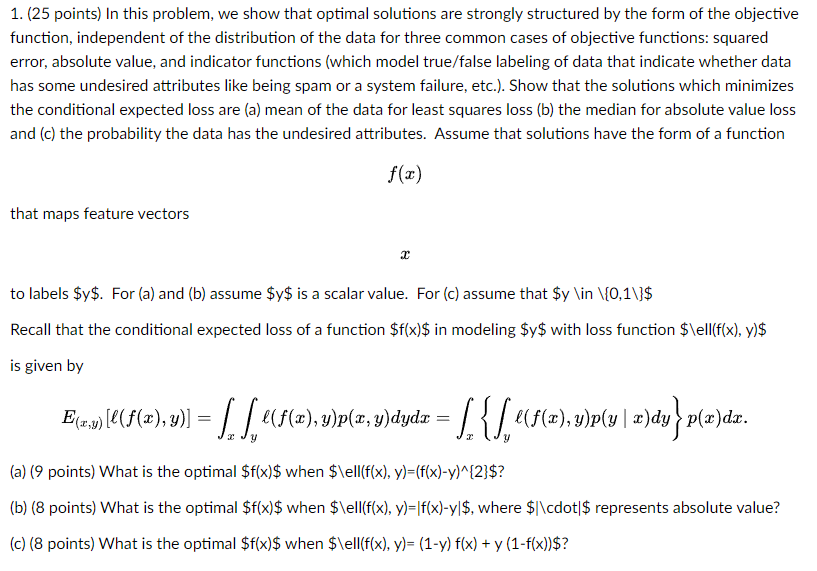Answered step by step
Verified Expert Solution
Question
1 Approved Answer
1. (25 points) In this problem, we show that optimal solutions are strongly structured by the form of the objective function, independent of the

1. (25 points) In this problem, we show that optimal solutions are strongly structured by the form of the objective function, independent of the distribution of the data for three common cases of objective functions: squared error, absolute value, and indicator functions (which model true/false labeling of data that indicate whether data has some undesired attributes like being spam or a system failure, etc.). Show that the solutions which minimizes the conditional expected loss are (a) mean of the data for least squares loss (b) the median for absolute value loss and (c) the probability the data has the undesired attributes. Assume that solutions have the form of a function f(x) that maps feature vectors x to labels $y$. For (a) and (b) assume $y$ is a scalar value. For (c) assume that $y \in \{0,1\}$ Recall that the conditional expected loss of a function $f(x)$ in modeling $y$ with loss function $\ell(f(x), y)$ is given by = E{(x,y) [l(f(x), y)] = [ [ l(f(x), y)p(x, y)dydz : = [ { [_l(f(x), y)p(y | x)dy} p(x)dx. (a) (9 points) What is the optimal $f(x)$ when $\ell(f(x), y)=(f(x)-y)^{2}$? (b) (8 points) What is the optimal $f(x)$ when $\ell(f(x), y)=f(x)-y|$, where $\cdot|$ represents absolute value? (c) (8 points) What is the optimal $f(x)$ when $\ell(f(x), y)= (1-y) f(x) + y (1-f(x))$?
Step by Step Solution
★★★★★
3.45 Rating (161 Votes )
There are 3 Steps involved in it
Step: 1
The question provided is related to finding the optimal solutions for different loss functions in a ...
Get Instant Access to Expert-Tailored Solutions
See step-by-step solutions with expert insights and AI powered tools for academic success
Step: 2

Step: 3

Ace Your Homework with AI
Get the answers you need in no time with our AI-driven, step-by-step assistance
Get Started


